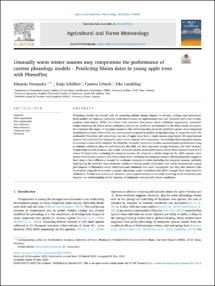Unusually warm winter seasons may compromise the performance of current phenology modelsPredicting bloom dates in young apple trees with PhenoFlex

Unusually warm winter seasons may compromise the performance of current phenology models
Predicting bloom dates in young apple trees with PhenoFlex

| dc.contributor.author | Fernandez, Eduardo | |
| dc.contributor.author | Schiffers, Katja | |
| dc.contributor.author | Urbach, Carsten | |
| dc.contributor.author | Luedeling, Eike | |
| dc.date.accessioned | 2023-04-28T08:58:32Z | |
| dc.date.available | 2023-04-28T08:58:32Z | |
| dc.date.issued | 15.07.2022 | |
| dc.identifier.uri | https://hdl.handle.net/20.500.11811/10786 | |
| dc.description.abstract | Phenology models are crucial tools for assessing climate change impacts in forestry, ecology and agriculture. Such models are typically calibrated with observational or experimental data and validated with a set of independent observations. While there have been extensive discussions about validation approaches, systematic studies assessing the effects of the calibration data on the predictive performance of the fitted model are scarce. We evaluated the impact of marginal seasons in the calibration data set on the predictive power of an integrated modeling framework (PhenoFlex) that was recently proposed to predict spring phenology in temperate trees. We calibrated PhenoFlex with phenology records of apple trees from a multi-season experiment (59 experimental seasons) that included five unusually warm winter seasons. For comparison, we excluded these marginal seasons in a second version of the analysis. We fitted the 12 model parameters to data, assessed model performance using a common validation data set and evaluated the chill and heat responses during dormancy for both versions. Despite high overall accuracy, our results indicated a better model performance (Root Mean Square Errors of 2.3 versus 5.5 days) when excluding the marginal seasons. We observed a similar shape for the chill response curve across versions but a greater chill effectiveness when including the marginal seasons. Fitted parameters suggest a hard drop in heat efficiency beyond the optimum temperature when including the marginal seasons, probably highlighting the need for more moderate conditions during model calibration. Our results demonstrate a good performance of PhenoFlex when calibration and validation data were comparable, but they also indicate risks involved in using the framework to project phenology under conditions that differ strongly from those used for calibration. Further evaluation and validation under experimentally or naturally occurring warm conditions may improve our understanding of the response of temperate trees to mild winter conditions. | en |
| dc.format.extent | 11 | |
| dc.language.iso | eng | |
| dc.rights | Namensnennung 4.0 International | |
| dc.rights.uri | http://creativecommons.org/licenses/by/4.0/ | |
| dc.subject | Chill requirement | |
| dc.subject | Heat requirement | |
| dc.subject | Tree dormancy | |
| dc.subject | Malus domestica | |
| dc.subject | Temperate trees | |
| dc.subject | Flowering | |
| dc.subject.ddc | 333.7 Natürliche Ressourcen, Energie und Umwelt | |
| dc.subject.ddc | 580 Pflanzen (Botanik) | |
| dc.title | Unusually warm winter seasons may compromise the performance of current phenology models | |
| dc.title.alternative | Predicting bloom dates in young apple trees with PhenoFlex | |
| dc.type | Wissenschaftlicher Artikel | |
| dc.publisher.name | Elsevier | |
| dc.rights.accessRights | openAccess | |
| dcterms.bibliographicCitation.volume | 2022, vol. 322 | |
| dcterms.bibliographicCitation.issue | no. 109020 | |
| dcterms.bibliographicCitation.pagestart | 1 | |
| dcterms.bibliographicCitation.pageend | 11 | |
| dc.relation.doi | https://doi.org/10.1016/j.agrformet.2022.109020 | |
| dcterms.bibliographicCitation.journaltitle | Agricultural and Forest Meteorology | |
| ulbbn.pubtype | Zweitveröffentlichung | |
| dc.version | publishedVersion | |
| ulbbn.sponsorship.oaUnifund | OA-Förderung Universität Bonn |
Dateien zu dieser Ressource
Das Dokument erscheint in:
-
Publikationen (13)




